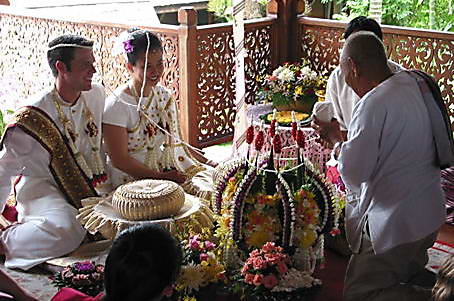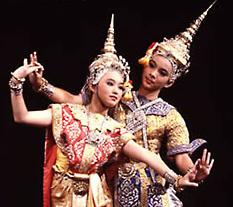This
is a traditional dress that women and girls
of all ages wear for dances and
celebrations. 
 Before wedding bells
can be heard in Thailand, the
couple getting married prepares food for the monks. In return, the
monks will give the bride and groom a blessing. Wedding ceremonies in
Thailand usually include only relatives and close friends of the
couple. It is a Thai marriage ritual for the bride and
groom to sit together on the floor, each with their hands pressed
together, fingers pointing up under their chins. The couple's hands are
also linked by a chain of flowers. The oldest relative leads the
wedding ceremony and to wish the couple luck, he dips their hands in a
conch shell containing water. Their parents and other guests will then
do the same. In rural areas, an elderly couple may arrange the
bridal bed for the newlyweds and leave good luck tokens such as; rice,
sesame seeds and coins. This Thai wedding custom symbolizes good luck
and fertility.
Before wedding bells
can be heard in Thailand, the
couple getting married prepares food for the monks. In return, the
monks will give the bride and groom a blessing. Wedding ceremonies in
Thailand usually include only relatives and close friends of the
couple. It is a Thai marriage ritual for the bride and
groom to sit together on the floor, each with their hands pressed
together, fingers pointing up under their chins. The couple's hands are
also linked by a chain of flowers. The oldest relative leads the
wedding ceremony and to wish the couple luck, he dips their hands in a
conch shell containing water. Their parents and other guests will then
do the same. In rural areas, an elderly couple may arrange the
bridal bed for the newlyweds and leave good luck tokens such as; rice,
sesame seeds and coins. This Thai wedding custom symbolizes good luck
and fertility.
The average Thailand wedding would be the best day of their lives. The women's wedding dress would look like this.....
 Beautiful and Extravagant!!!
Beautiful and Extravagant!!!
The average children in Thailand wear clothing that is different than Americans. They wear somewhat "puffy" clothing and dressy clothes with the flowers and scarves.

Women in Thailand where blouses or dresses. This is a photo of a blouse that women in Thailand and Americans wear for a normal outing or just to go around town.

- The Thai language is has a different alphabet like, 44 consonants, 32 vowels and five tones in Thai pronunciation, along with a script that has Indian origins. The Thai language, belonging to the Thai family, is the main language in Thailand although there are several regional dialects as well. Other languages spoken in Thailand are Chinese, Lao, Malay and Mon-Khmer, while English use is becoming more prevalent in government and commerce.
- The wai, wai is the common form of greeting to strict rules of protocol, is the traditional form of greeting, given by the person of lower status to the person of higher status. Thais generally use first rather than surnames, with the honorific title, Khun, before the name. Khun is an all- purpose form of address that is appropriate for both men and women. In general, they wait for their host and hostess to introduce you to the other guests. This allows everyone to understand your status relative to their own, and thus know who performs the wai and how low the head should be bowed.
 -
For a sign of respect and greeting, when you raising both hands, palms
joined with the
fingers pointing upwards as
if in prayer, lightly touching the body somewhere between the chest and
the forehead, is the standard form. Respect and courtesy are
demonstrated by
the height at which the hands are held and how low the head comes down
to meet the thumbs of both hands. The wai may be made while sitting,
walking, or standing. The person who is junior in age or status is the
first one to offer the wai. The senior person returns the wai,
generally with their hands raised to somewhere around their chest. If
a junior person is standing and wants to wai a senior person who is
seated, the junior will stoop or bow their head while making the
wai. If there is a great social distance between two people, the wai
will not be returned.
-
For a sign of respect and greeting, when you raising both hands, palms
joined with the
fingers pointing upwards as
if in prayer, lightly touching the body somewhere between the chest and
the forehead, is the standard form. Respect and courtesy are
demonstrated by
the height at which the hands are held and how low the head comes down
to meet the thumbs of both hands. The wai may be made while sitting,
walking, or standing. The person who is junior in age or status is the
first one to offer the wai. The senior person returns the wai,
generally with their hands raised to somewhere around their chest. If
a junior person is standing and wants to wai a senior person who is
seated, the junior will stoop or bow their head while making the
wai. If there is a great social distance between two people, the wai
will not be returned.

Click on the picture to watch a video about Thailand's Culture!

 Before wedding bells
can be heard in Thailand, the
couple getting married prepares food for the monks. In return, the
monks will give the bride and groom a blessing. Wedding ceremonies in
Thailand usually include only relatives and close friends of the
couple. It is a Thai marriage ritual for the bride and
groom to sit together on the floor, each with their hands pressed
together, fingers pointing up under their chins. The couple's hands are
also linked by a chain of flowers. The oldest relative leads the
wedding ceremony and to wish the couple luck, he dips their hands in a
conch shell containing water. Their parents and other guests will then
do the same. In rural areas, an elderly couple may arrange the
bridal bed for the newlyweds and leave good luck tokens such as; rice,
sesame seeds and coins. This Thai wedding custom symbolizes good luck
and fertility.
Before wedding bells
can be heard in Thailand, the
couple getting married prepares food for the monks. In return, the
monks will give the bride and groom a blessing. Wedding ceremonies in
Thailand usually include only relatives and close friends of the
couple. It is a Thai marriage ritual for the bride and
groom to sit together on the floor, each with their hands pressed
together, fingers pointing up under their chins. The couple's hands are
also linked by a chain of flowers. The oldest relative leads the
wedding ceremony and to wish the couple luck, he dips their hands in a
conch shell containing water. Their parents and other guests will then
do the same. In rural areas, an elderly couple may arrange the
bridal bed for the newlyweds and leave good luck tokens such as; rice,
sesame seeds and coins. This Thai wedding custom symbolizes good luck
and fertility.The average Thailand wedding would be the best day of their lives. The women's wedding dress would look like this.....
 Beautiful and Extravagant!!!
Beautiful and Extravagant!!!The average children in Thailand wear clothing that is different than Americans. They wear somewhat "puffy" clothing and dressy clothes with the flowers and scarves.

Women in Thailand where blouses or dresses. This is a photo of a blouse that women in Thailand and Americans wear for a normal outing or just to go around town.

- The Thai language is has a different alphabet like, 44 consonants, 32 vowels and five tones in Thai pronunciation, along with a script that has Indian origins. The Thai language, belonging to the Thai family, is the main language in Thailand although there are several regional dialects as well. Other languages spoken in Thailand are Chinese, Lao, Malay and Mon-Khmer, while English use is becoming more prevalent in government and commerce.
- The wai, wai is the common form of greeting to strict rules of protocol, is the traditional form of greeting, given by the person of lower status to the person of higher status. Thais generally use first rather than surnames, with the honorific title, Khun, before the name. Khun is an all- purpose form of address that is appropriate for both men and women. In general, they wait for their host and hostess to introduce you to the other guests. This allows everyone to understand your status relative to their own, and thus know who performs the wai and how low the head should be bowed.
 -
For a sign of respect and greeting, when you raising both hands, palms
joined with the
fingers pointing upwards as
if in prayer, lightly touching the body somewhere between the chest and
the forehead, is the standard form. Respect and courtesy are
demonstrated by
the height at which the hands are held and how low the head comes down
to meet the thumbs of both hands. The wai may be made while sitting,
walking, or standing. The person who is junior in age or status is the
first one to offer the wai. The senior person returns the wai,
generally with their hands raised to somewhere around their chest. If
a junior person is standing and wants to wai a senior person who is
seated, the junior will stoop or bow their head while making the
wai. If there is a great social distance between two people, the wai
will not be returned.
-
For a sign of respect and greeting, when you raising both hands, palms
joined with the
fingers pointing upwards as
if in prayer, lightly touching the body somewhere between the chest and
the forehead, is the standard form. Respect and courtesy are
demonstrated by
the height at which the hands are held and how low the head comes down
to meet the thumbs of both hands. The wai may be made while sitting,
walking, or standing. The person who is junior in age or status is the
first one to offer the wai. The senior person returns the wai,
generally with their hands raised to somewhere around their chest. If
a junior person is standing and wants to wai a senior person who is
seated, the junior will stoop or bow their head while making the
wai. If there is a great social distance between two people, the wai
will not be returned.
Click on the picture to watch a video about Thailand's Culture!